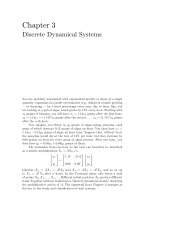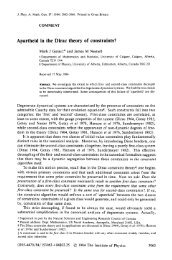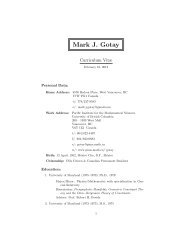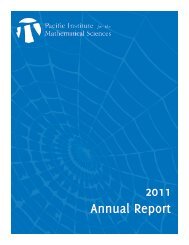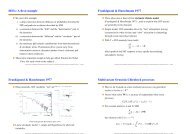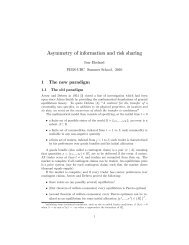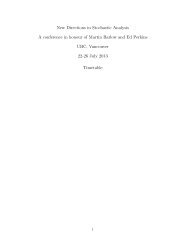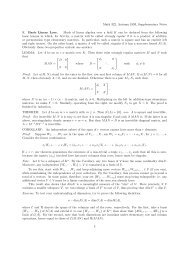51 PRIMA 2013 AbstractsJongyook ParkUniversity of Science and Technology of China, Chinajongyook@hanmail.netIn 2006, Bannai and Bannai classified primitive symmetricassoci<strong>at</strong>ion schemes with m 1 = 3. In their paper, thehardest case was k 1 = 3. Even though, (primitive) symmetricassoci<strong>at</strong>ion schemes with k 1 = 3 were classified byYamazaki in 1998, they avoided the use of the difficultand deep result of Yamazaki. In this talk, we generalizethe result of Bannai and Bannai.Triangul<strong>at</strong>ed c<strong>at</strong>egories from c<strong>at</strong>egories ofspecail exact squencesKeyan Song, Yuehui ZhangShanghai Jiao Tong University, Chinazyh@sjtu.edu.cnLet A be an artinian algebra over an algebraically closedfield k. Let F be the c<strong>at</strong>egory consisting of all four-termexact sequences in modA. Let C be the full subc<strong>at</strong>egory ofF consisting of all exact sequences with two middle termsprojective modules in modA. It is proved th<strong>at</strong> C is contravariantlyfinite. As applic<strong>at</strong>ions, it is proved th<strong>at</strong> C is aFrobenius c<strong>at</strong>egory and has Auslander-Reiten sequencesprovided A is an selfinjective algebra. Furthermore, it isproved th<strong>at</strong> the stable c<strong>at</strong>egory C equals to C/H as factorc<strong>at</strong>egories, where H is the set of all homotopic rel<strong>at</strong>ions,and they are both equivalent to the stable c<strong>at</strong>egory modA.An interesting result is th<strong>at</strong> these three c<strong>at</strong>egories C, C/Hand modA are equivalent as triangul<strong>at</strong>ed c<strong>at</strong>egories.Contributed Talks Group 3Discrete M<strong>at</strong>hem<strong>at</strong>icsNumerical verific<strong>at</strong>ion method for well conditionedspherical t-designsCongpei AnJinan University, Chinaandbach@163.comA set X N of N points on the unit sphere is a sphericalt-design if the average value of any polynomial of degree<strong>at</strong> most t over X N is equal to the average value of thepolynomial over the sphere. In this talk, we focus on thecomput<strong>at</strong>ional construction of spherical t-designs on theunit sphere S 2 ⊂ R 3 when N ≥ (t + 1) 2 , the dimension ofthe space P t of spherical polynomials of degree <strong>at</strong> mostt. We show how to construct well conditioned sphericaldesigns with N ≥ (t+1) 2 points by maximizing the determinantof a m<strong>at</strong>rix while s<strong>at</strong>isfying a system of nonlinearconstraints for 1 ≤ t ≤ 100. Interval methods are thenused to prove the existence of a true spherical t-designvery close to the calcul<strong>at</strong>ed points and to provide a guaranteedinterval containing the determinant. The resultingspherical designs have good geometrical properties (separ<strong>at</strong>ionand mesh norm). We discuss some open problemson the distribution of point set over the sphere.This is a joint work with X.Chen, I. H. Sloan and R. S.Womersley.Edge colouring graphs with bounded colourclassesDavid CariolaroXi’an Jiaotong-Liverpool University, Chinadavid.cariolaro@xjtlu.edu.cnAn edge colouring of a graph G is a function which assignsa colour to each edge of G in such a way th<strong>at</strong> adjacentedges receive distinct colours. The minimum number ofcolours used by an edge colouring of G is a well knownand studied graph parameter called chrom<strong>at</strong>ic index anddenoted by χ ′ (G). It was proved by Holyer in 1981 th<strong>at</strong>computing χ ′ (G) is in general NP-hard. We consider avari<strong>at</strong>ion of the edge colouring problem, which may beof interest for applic<strong>at</strong>ions. Specifically, we consider edgecolourings of G such th<strong>at</strong> no colour is assigned to morethan B edges, where B is a positive integer fixed in advance(clearly such edge colourings always exist). We callany such colouring a B-bounded edge colouring of G. Theminimum number of colours in a B-bounded edge colouringof G is a graph parameter which we denote by χ ′ B (G)and call B-bounded chrom<strong>at</strong>ic index. A B-bounded edgecolouring which uses exactly χ ′ B (G) colours is called anoptimal B-bounded edge colouring of G.It is not difficult to see th<strong>at</strong>, for every graph G,χ ′ B (G) = max{χ′ (G), ⌈ |E(G)|B ⌉.This prompts the question of whether the parameter χ ′ Band an optimal B-bounded edge colouring can be computedin polynomial time for a fixed value of B. Ourgoal in this talk will be to answer this question in theaffirm<strong>at</strong>ive. This is joint work with Romeo Rizzi [1].[1] R. Rizzi and D. Cariolaro, Polynomial time complexityof Edge Colouring Graphs with Bounded Colour Classes,Algorithmica (2013), in press, doi: 10.1007/s00453-013-9746-7.Realizing joint degree m<strong>at</strong>ricesAaron DutleUniversity of South Carolina, USAdutle@m<strong>at</strong>h.sc.eduThe Joint Degree M<strong>at</strong>rix of a graph is a m<strong>at</strong>rix whose(i, j) entry is the number of edges connecting vertices ofdegree i to vertices of degree j. A given m<strong>at</strong>rix is calledrealizable if it is the joint degree m<strong>at</strong>rix of a simple graph.As in the case of degree sequences, there is a simple set ofconditions for when a m<strong>at</strong>rix is realizable, as well as anoper<strong>at</strong>ion th<strong>at</strong> can be used to transform any realiz<strong>at</strong>ioninto any other realiz<strong>at</strong>ion. We discuss these problems,as well as the extremal question of when a joint degreem<strong>at</strong>rix is uniquely realizable.Generaliz<strong>at</strong>ion of Legendre polynomials theoryLemin GuTongji University, Chinagulemin@tongji.edu.cnIn all of n-order polynomials th<strong>at</strong> highest coefficientis 1čňLegendre polynomials are in the interval [−1, 1]with the least square error of zero polynomials, th<strong>at</strong> forP∫n(x) = x n + a(n − 1)x n−1 + ... + a1x + a0, making[P n(x)] 2 dx = min. Promotes the Legendre multinomialbasicprinciple: In all of n-order polynomials th<strong>at</strong> highestcoefficient is not 1, namely an ≠ 1,there must be a newpolynomials Gn(x) = x n + a(n − 1)x n−1 + ... + a1x + a0,making ∫ [Gn(x)] 2 dx = min. Through discussion of thesquare error minimiz<strong>at</strong>ion, leads to the new polynomialsestablishment necessity. For convenient on elabor<strong>at</strong>ionin this abstract,called it "Gn(x) polynomial" (Generaliz<strong>at</strong>ionof Legendre polynomial). First the existenceof Gn(x) polynomials issues are studied: By establishingGn(x) equ<strong>at</strong>ion the ordinary solution expressions in the
52 PRIMA 2013 Abstractsinterval |x| < 1 are given, have proven th<strong>at</strong> when n is positiveinteger and the interval is in |x| ≤ 1, two linear independencespecial solutions of them are Gn(x) polynomials,and provide the general term expression; Second, thegeometric meaning of Gn(x) polynomials are discussed,have proven th<strong>at</strong> Gn(x)polynomials are the polynomialsth<strong>at</strong> in [−1, 1] with the error squares value are the least;Third, the main properties of Gn(x) polynomials are introducedčňwhichincluding Gn(x)polynomials recurrenceformula, the orthogonality, the odevity, the squares valuearea, the former n=9 polynomials, the corresponding geometry,and so on. Last, some special applic<strong>at</strong>ions ofGn(x) polynomials under different boundary conditionsare given: Combined with the best Chebyshev approxim<strong>at</strong>iontheory they can constitute maximum error minimizingleast square approxim<strong>at</strong>ion; Combined with theLeast Absolute Devi<strong>at</strong>ion approxim<strong>at</strong>ion theory can constitutezero error type least square approxim<strong>at</strong>ion; Underthe conditions of an=1 form the Legendre polynomial,andso on.The subsets counting problems and their applic<strong>at</strong>ionsJiyou LiShanghai Jiao Tong University, Chinalijiyou@sjtu.edu.cnLet G be an abelian group and D be a finite subset of G.∑Denote N(b) to be the number of subsets S in D such th<strong>at</strong>x∈S x = b and N k(b) to be the number of k-subsets Sin D such th<strong>at</strong> ∑ x∈S x = b. When G is the set of integers,the decision version of the subset sum problem, i.e.,determining if N(b) > 0, is a well-known NP-completeproblem. And its counting version, the explicit enumer<strong>at</strong>ionof N(b) or N k (b), is a #P-complete problem. Inthis talk, we will investig<strong>at</strong>e these problems from a m<strong>at</strong>hem<strong>at</strong>icalpoint of view, and introduce their rel<strong>at</strong>ions toadditive combin<strong>at</strong>orics, coding theory and computer sciences.P<strong>at</strong>hs and cycles of interval graphsPeng LiShanghai Jiao Tong University, Chinalidetiansjtu@sjtu.edu.cnWe recently find a linear time algorithm for solving the 1-Fixed-Endpoint P<strong>at</strong>h Cover Problem on interval graphs.The design and the analysis of this algorithm motiv<strong>at</strong>eus to develop many properties on the p<strong>at</strong>hs and cycles ofinterval graphs and graphs. In this short present<strong>at</strong>ion, wereport a series of equivalent characteriz<strong>at</strong>ions of Hamiltonianconnectedness and other p<strong>at</strong>h/cycle properties ofinterval graphs.This is joint work with Yaokun Wu.The spectrum of 3-way k-homogeneous L<strong>at</strong>intradesTrent G. MarbachThe University of Queensland, Australi<strong>at</strong>rent.marbach@uqconnect.edu.auThe theory of L<strong>at</strong>in trades has a deep and interestingstructure, with connections to permut<strong>at</strong>ion groups, geometryand topology. The study of µ-way k-homogeneousL<strong>at</strong>in trades has received <strong>at</strong>tention recently. The effortsof five public<strong>at</strong>ions completed the spectrum of the ordersof 2-way k-homogeneous L<strong>at</strong>in trades. This was followedby a recent paper (Bagheri Gh., et al. 2012), whichfocused particularly on the 3-way k-homogeneous L<strong>at</strong>intrades with k ≤ 15. In this talk, I will give a brief reporton the existence of µ-way k-homogeneous L<strong>at</strong>in trades,including three new constructions th<strong>at</strong> complete the 3-way k-homogeneous L<strong>at</strong>in trade spectrum for all but ahandful of values. We will also provide the directions forfurther research motiv<strong>at</strong>ed by this work.On the fractional metric dimension of treegraphsSuhadi Wido SaputroInstitut Teknologi Bandung, Indonesiasuhadi@m<strong>at</strong>h.itb.ac.idLet G be a finite, simple, and connected graph. The distancebetween any two vertices u, v ∈ V (G), denoted byd G (u, v), is the length of a shortest (u − v) p<strong>at</strong>h in G.A vertex x ∈ V (G) is called resolve a pair {u, v} of verticesof G if d G (u, x) ≠ d G (v, x). For u, v ∈ V (G), theset of all vertices which resolve the pair {u, v} is denotedby R G {u, v}. A real value function g : V (G) → [0, 1]is called a resolving function of G if g(R G {u, v}) ≥ 1for any two distinct vertices u, v ∈ V (G). The fractionalmetric dimension, denoted by dim f (G), is givenby dim f (G) = min{|g| : g is a resolving function of G},where |g| = g(V (G)). In this paper, we determine thefractional metric dimension for tree graph T n of ordern ≥ 3.Unimodality of genus distribution of laddersLiangxia WanBeijing Jiaotong University, Chinalxwan@bjtu.edu.cnGiven a graph,its genus distribution is unimodal? Asthough many results about genus distribution of graphshave obtained, there are only several those about unimodalityof genus distribution of graphs. In this talk,unimodality of genus distri- bution of some graphs areverified.The lit-only σ-gameZiqing XiangShanghai Jiao Tong University, ChinaZiqingXiang@gmail.comLet G be a finite graph with vertex set V which may notnecessarily be loopless. For each v ∈ V , let α v ∈ F V 2 bethe map which takes value 1 on w ∈ V if and only if thereis an edge between v and w in G; let T v be the linear mapon F V 2 th<strong>at</strong> sends x ∈ FV 2 to itself if x(v) = 0 and sendsx ∈ F V 2 to x + αv if x(v) = 1. Note th<strong>at</strong> Tv is a transvectionwhen v is not a loop in G while T v is an idempotentwhen v is a loop in G. We consider the digraph Γ withvertex set F V 2 and arc set {(x, Tv(x) : x ∈ FV 2 , v ∈ V },which is the phase space of the lit-only σ-game on G.We determine the reachability rel<strong>at</strong>ion for the digraph Γ.A surprising corollary of this work is th<strong>at</strong>, for α, β ∈ F V 2 ,basically, α can reach β in Γ if and only if α − β lies inthe binary linear subspace spanned by {α v : v ∈ V }.An important step of our work is to define the line graphof a multigraph and to provide a forbidden subgraph characteriz<strong>at</strong>ion.If the graph G is loopless, as an applic<strong>at</strong>ionof our knowledge of the corresponding digraph Γ, we areable to determine the multiplic<strong>at</strong>ive group gener<strong>at</strong>ed by{T v : v ∈ V }. We also indic<strong>at</strong>e possible approaches onextending the work here to the general case of G being adigraph.This is joint work with Yaokun Wu.
- Page 2 and 3:
1PRIMA 2013-Table of ContentsTable
- Page 4 and 5:
3PRIMA 2013-OrganizationOrganizatio
- Page 6 and 7:
5PRIMA 2013-OrganizationYoshikazu G
- Page 8 and 9:
7PRIMA 2013-Useful InformationUsefu
- Page 10 and 11:
9PRIMA 2013-Useful InformationTaxi:
- Page 12 and 13:
11PRIMA 2013-Useful Informationmath
- Page 14 and 15:
13PRIMA 2013 Program-Schedule-at-a-
- Page 16 and 17:
15PRIMA 2013 Program-Monday, June 2
- Page 18 and 19:
17PRIMA 2013 Program-Monday, June 2
- Page 20 and 21:
19PRIMA 2013 Program-Monday, June 2
- Page 22 and 23:
21PRIMA 2013 Program-Monday, June 2
- Page 24 and 25:
23PRIMA 2013 Program-Tuesday, June
- Page 26 and 27:
25PRIMA 2013 Program-Tuesday, June
- Page 29 and 30:
28PRIMA 2013 Program-Tuesday, June
- Page 31 and 32:
30PRIMA 2013 Program-Tuesday, June
- Page 33 and 34:
32PRIMA 2013 Program-Wednesday, Jun
- Page 35 and 36:
34PRIMA 2013 Program- Thursday, Jun
- Page 37 and 38:
36PRIMA 2013 Program- Thursday, Jun
- Page 39 and 40:
38PRIMA 2013 Program- Thursday, Jun
- Page 41 and 42:
40PRIMA 2013 Program- Thursday, Jun
- Page 43 and 44:
42PRIMA 2013 Program- Friday, June
- Page 45 and 46:
44PRIMA 2013 Program- Friday, June
- Page 48 and 49: 1 PRIMA 2013 AbstractsContents1 Pub
- Page 50 and 51: 3 PRIMA 2013 Abstractsof subfactors
- Page 52 and 53: 5 PRIMA 2013 AbstractsprocessesXu S
- Page 54 and 55: 7 PRIMA 2013 AbstractsIn this talk
- Page 56 and 57: 9 PRIMA 2013 Abstractsindependently
- Page 58 and 59: 11 PRIMA 2013 AbstractsEnumerating,
- Page 60 and 61: 13 PRIMA 2013 AbstractsRyuhei Uehar
- Page 62 and 63: 15 PRIMA 2013 AbstractsIn this talk
- Page 64 and 65: 17 PRIMA 2013 AbstractsSpecial Sess
- Page 66 and 67: 19 PRIMA 2013 Abstractscritical slo
- Page 68 and 69: 21 PRIMA 2013 AbstractsSpecial Sess
- Page 70 and 71: 23 PRIMA 2013 Abstractsstrictly awa
- Page 72 and 73: 25 PRIMA 2013 AbstractsPedram Hekma
- Page 74 and 75: 27 PRIMA 2013 Abstractsis well-know
- Page 76 and 77: 29 PRIMA 2013 Abstractssolid substr
- Page 78 and 79: 31 PRIMA 2013 AbstractsRapoport-Zin
- Page 80 and 81: 33 PRIMA 2013 Abstractssense. Our a
- Page 82 and 83: 35 PRIMA 2013 AbstractsIn an econom
- Page 84 and 85: 37 PRIMA 2013 AbstractsKyoto Univer
- Page 86 and 87: 39 PRIMA 2013 AbstractsAlexander Mo
- Page 88 and 89: 41 PRIMA 2013 AbstractsOsamu SaekiK
- Page 90 and 91: 43 PRIMA 2013 Abstractsopen Delzant
- Page 92 and 93: 45 PRIMA 2013 AbstractsJian ZhouTsi
- Page 94 and 95: 47 PRIMA 2013 AbstractsJiaqun WeiNa
- Page 96 and 97: 49 PRIMA 2013 Abstractsthe end of 2
- Page 100 and 101: 53 PRIMA 2013 AbstractsPancyclicity
- Page 102 and 103: 55 PRIMA 2013 AbstractsEfficient nu
- Page 104 and 105: 57 PRIMA 2013 Abstractsand fountain
- Page 106: 59 PRIMA 2013 Abstractsformula esti



